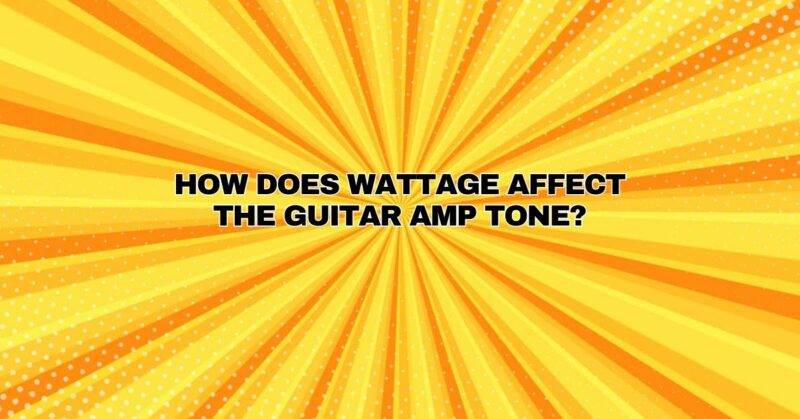The world of guitar amplifiers is a realm of sonic possibilities, and one crucial factor that significantly influences your tone is amp wattage. The wattage of a guitar amp isn’t just about volume; it plays a pivotal role in shaping the character and response of your guitar’s sound. In this article, we’ll explore how wattage affects the tone of a guitar amp and why it’s an essential consideration for musicians seeking their ideal sound.
1. Clean Headroom and Volume:
The most apparent way in which wattage affects amp tone is through volume and clean headroom. In simple terms, wattage determines how loud your amp can get before it starts to break up and distort. Here’s how it works:
- Low-Wattage Amps (1-20 Watts): These amps tend to break up and distort at lower volume levels, making them ideal for achieving that sweet, saturated overdrive at manageable volumes. They often provide rich harmonic content in the form of warm tube saturation, even at lower settings.
- Medium-Wattage Amps (20-50 Watts): Medium-wattage amps offer a balance between clean headroom and overdrive. They can produce louder, cleaner tones before distortion sets in, making them versatile for various playing styles.
- High-Wattage Amps (50 Watts and Above): High-wattage amps are known for their clean headroom, meaning they can reach high volumes without breaking up. This clean tone is desirable for genres where pristine, undistorted sound is essential, such as jazz or country.
2. Speaker Response and Interaction:
Another critical aspect influenced by wattage is the interaction between your amp and its speakers. High-wattage amps can drive larger speaker cabinets with multiple speakers, resulting in a broader frequency response and enhanced projection. This configuration can significantly impact your tone:
- Low-Wattage Amps: Smaller amps with lower wattage often pair well with smaller speakers, resulting in a more focused and midrange-heavy tone. This setup is popular for achieving classic rock and blues tones with an emphasis on midrange warmth and breakup.
- High-Wattage Amps: Amps with higher wattage can power larger cabinets with multiple speakers, producing a wider frequency spectrum and greater volume. This setup excels in genres where a full, deep, and powerful tone is essential, such as hard rock or metal.
3. Dynamic Response:
Amp wattage also affects the dynamic response of your amplifier. This refers to how your amp reacts to your playing dynamics, such as picking strength and guitar volume adjustments. The relationship between wattage and dynamic response can be summarized as follows:
- Low-Wattage Amps: Smaller amps tend to respond more dynamically to your playing nuances. They can easily transition from clean to overdriven tones with changes in picking dynamics, making them ideal for expressive playing.
- High-Wattage Amps: High-wattage amps have a more compressed and less dynamic response at lower volumes. They often require more significant changes in playing dynamics to go from clean to overdriven tones.
4. Tone and Harmonic Characteristics:
The wattage of your amp also influences the tonal and harmonic characteristics of your guitar’s sound:
- Low-Wattage Amps: These amps often produce harmonic-rich overtones and a smooth, vintage-style distortion when pushed. The compression and saturation at lower volumes can result in a creamy, sweet overdrive.
- High-Wattage Amps: High-wattage amps tend to provide cleaner, more defined tones at higher volumes. The clean headroom allows for a pristine, clear sound that maintains its clarity even when played loudly.
Conclusion:
Wattage is a fundamental element in shaping the tone of a guitar amp. It affects clean headroom, speaker response, dynamic response, and the harmonic characteristics of your sound. When choosing an amp, consider your playing style, genre, and performance needs to find the right wattage that complements your musical journey. Whether you prefer the warm, vintage overdrive of a low-wattage amp or the clean, powerful tones of a high-wattage amp, understanding how wattage influences your tone is essential for crafting your ideal guitar sound.


